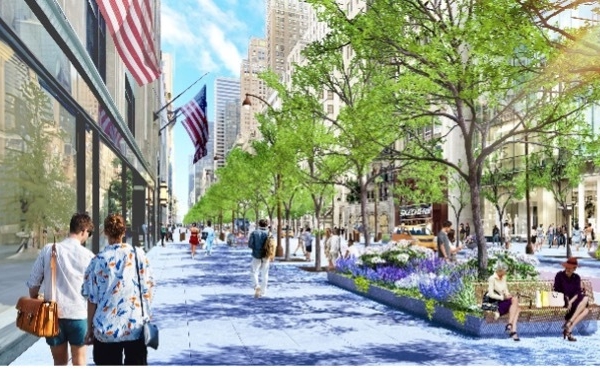New York City Mayor Adams and the “Future of Fifth Partnership” announced on October 17th the Manhattan Fifth Avenue renovation plan, aiming to transform Fifth Avenue between Bryant Park and Central Park into a world-class, pedestrian-centered tree-lined thoroughfare.
Adams stated that New York City should have an iconic tree-lined avenue that rivals those in other cities around the world. Currently, pedestrians make up 70% of the traffic on Fifth Avenue, with up to 23,000 people per hour during holidays, surpassing Madison Square Garden’s capacity by 4,000, yet only utilizing less than half of the space, leading to overcrowded sidewalks. This renovation project, jointly planned by the city government and the public-private “Future of Fifth Partnership,” will completely reshape the landscape along this shopping street and further drive economic and commercial development.
This marks the first major redesign of Fifth Avenue in 200 years. Presently, Fifth Avenue is 100 feet wide, consisting of five lanes of traffic and 23-foot wide sidewalks on each side.
The redesign draws inspiration from the historic landmarks and decorative arts along the avenue, as well as iconic shopping streets in other international cities, including Champs Elysees in Paris, Calle Serrano in Madrid, Bond St, Oxford St, and Regent St in London, and the planning of Ginza in Tokyo. The width of the sidewalks on both sides of Fifth Avenue will be nearly doubled, reaching 33.5 feet on each side, with a spacious 25-foot walking area, an 8.5-foot green space for trees, and a reduction of lanes from five to three.
In addition to balancing pedestrian and vehicular flow, over 230 trees will be added, along with 20,000 square feet of planting, seating, and event spaces to enhance lighting, aesthetics, and safety, further solidifying this iconic shopping corridor as a key economic and commercial engine for the city. The detailed planning of this project is set to be completed before next summer, with an estimated cost of $350 million. The city government anticipates that the increased real estate and sales tax revenue post-completion will recoup the costs within five years.
This ambitious initiative reflects a new chapter in the evolution of Fifth Avenue, revitalizing its charm and functionality for residents, visitors, and businesses alike, setting a new standard for urban landscape design and community engagement in the heart of New York City.

